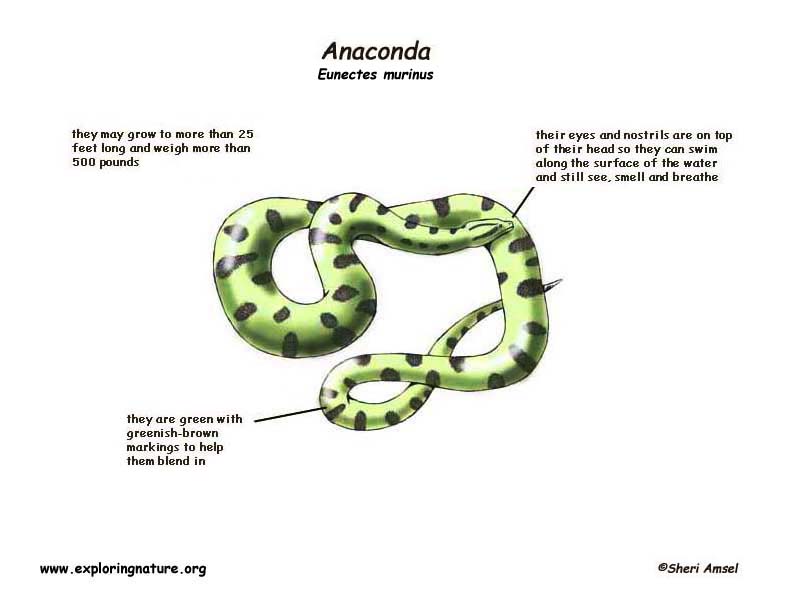

Anacondas are found in South America, east of the Andes Mountains. There are 4 species of anaconda: green anaconda, yellow anaconda, dark-spotted anaconda, Bolivian anaconda.
They live in tropical rain forests, grasslands, swamps, scrub forests and leafy (deciduous) forests. They like to be in the water but will sun on tree branches on riverbanks.
They may grow to more than 25 feet long and weigh more than 500 pounds. Females are larger. At its thickest point, an anaconda can measure a foot thick. They are the heaviest snakes in the world (though not the longest). Their eyes and nostrils are on top of their head so they can swim along the surface of the water. Their mottled brown color helps them blend in (camouflage). They coil in or near the water and wait for prey to come down to drink. They will grab prey and drown it before eating it. They can swallow prey much larger than the size of their mouth because their jaws can unhinge to take in the larger prey.
They are active at night (nocturnal) and live alone. Anacondas in the wild spend most of their time hanging out in rivers hunting for their food. They can live about 30 years.
They eat meat (carnivorous). They prey on capybaras, tapirs, deer, peccaries, fish, turtles, birds, sheep, dogs, reptiles and sometimes even jaguars. After eating big prey, they may not eat again for months.
Only baby anacondas are eaten by other predators. Adult anacondas are killed by man and losing habitat.
Females give a chemical smell (pheromone) that attracts males. Females are pregnant for 6 months (gestation). Then she has 20 - 40 live babies (not eggs). The babies are almost 2 feet long at birth and soon can swim and hunt for themselves.
Kingdom: Animalia
Phylum: Chordata
Subphylum: Vertebrata
Class: Reptilia
Order: Squamata
Suborder: Serpentes
Family: Boidae
Genus: Eunectes
Species: E. murinus
When you research information you must cite the reference. Citing for websites is different from citing from books, magazines and periodicals. The style of citing shown here is from the MLA Style Citations (Modern Language Association).
When citing a WEBSITE the general format is as follows.
Author Last Name, First Name(s). "Title: Subtitle of Part of Web Page, if appropriate." Title: Subtitle: Section of Page if appropriate. Sponsoring/Publishing Agency, If Given. Additional significant descriptive information. Date of Electronic Publication or other Date, such as Last Updated. Day Month Year of access < URL >.
Amsel, Sheri. "Anaconda" Exploring Nature Educational Resource ©2005-2024. December 17, 2024
< http://exploringnature.org/db/view/504 >

